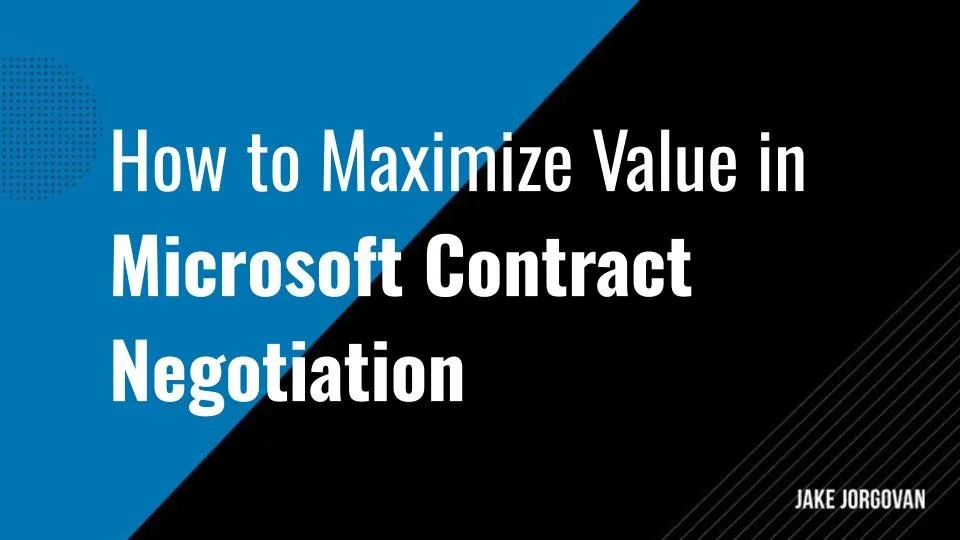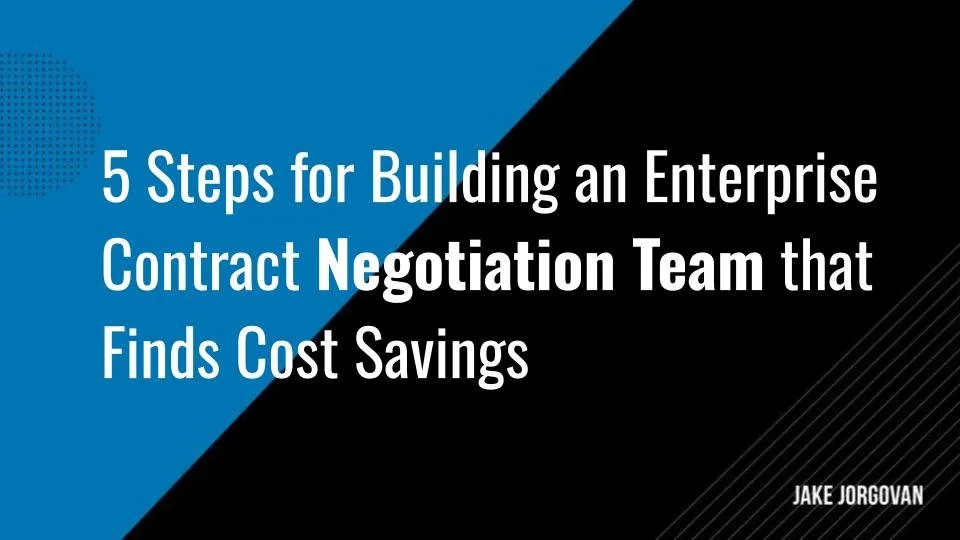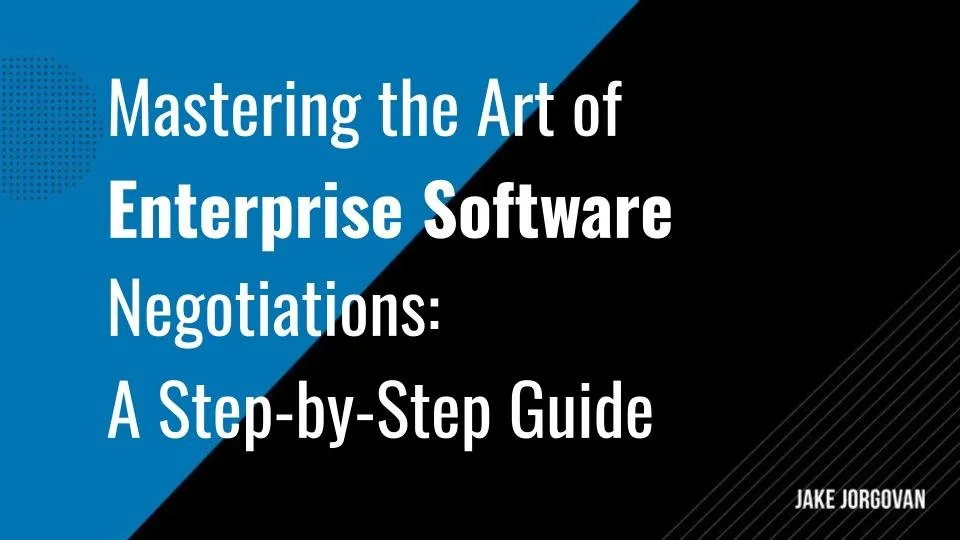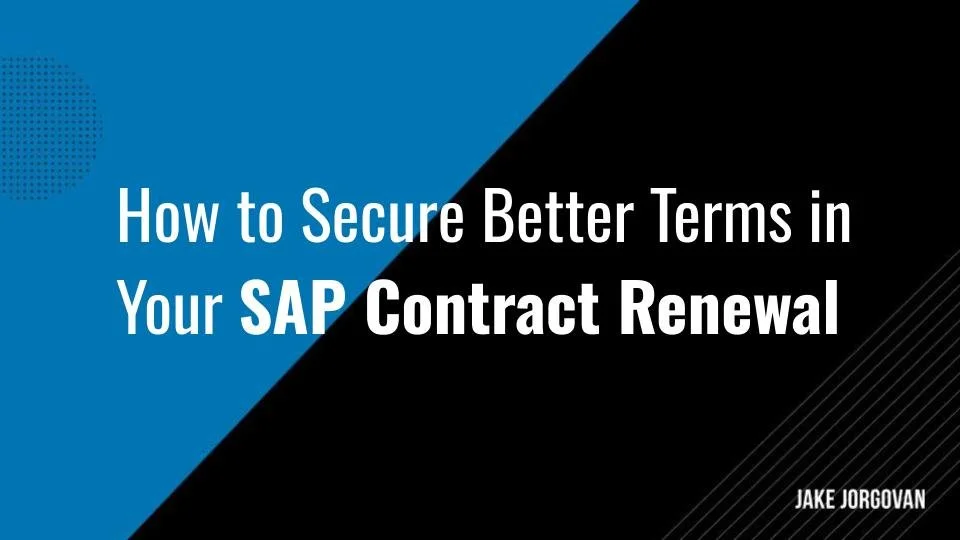How to Secure Better Terms in Your SAP Contract Renewal & Reduce Costs Without Compromising Performance
SAP contract renewals are notoriously challenging:
SAP dominates the market, holding a 6.2% share of the global ERP software market as of 2023.
Their aggressive sales tactics often leave companies at a disadvantage.
A misstep in negotiation can lead to higher costs and inflexible terms.
A well-planned strategy is the key to turning the tables.
With the right approach, you can secure better terms that align with your business goals.
In this article, we will show you how to prepare, negotiate, and succeed.
Let’s dive in and take control of the process before SAP dictates your terms.
Preparation: Laying the Groundwork for Your SAP Contract Renewal
Early Planning
Early planning sets the stage for a successful SAP contract renewal by allowing time to assess current needs, identify gaps, and strategize on leveraging potential SAP dependencies. For instance, SAP's 'Costs and Usage' analytics is a great tool to leverage. Use it to verify billing accurately and monitor resource consumption effectively.
Uncovering cost-saving opportunities and ensuring alignment with long-term business objectives provides negotiation leverage. Plus, you can avoid last-minute compromises.
Top SAP contract negotiation companies recommend starting negotiations at least six months ahead is a strategic maneuver that can significantly benefit your organization:
Avoid rush decisions: Early engagement prevents you from being pressured into unfavorable terms as deadlines loom.
Assess and align: This window allows you to thoroughly assess current software utilization and realign with evolving business goals. Are your current licenses over or under-utilized? Will future projects require additional modules? These questions need careful consideration away from the pressure of impending deadlines.
Strategic leverage: Use this time to build a comprehensive case for negotiations. Gather data on market pricing, competitor terms, and potential vendor alternatives. This information not only strengthens your position but also provides fallback options that enhance your bargaining power.
Each step ensures you enter renewal discussions informed, prepared, and ready to secure terms that support your strategic business objectives.
Mistakes to avoid: Failing to monitor SAP’s historical pricing trends and discount patterns can leave you unaware of potential negotiation opportunities. That means you can end up paying more than necessary for similar terms.
Pro tip: Map out SAP’s product roadmap and upcoming releases. Leverage this insight by aligning your contract’s scope and duration with these timelines, ensuring you capitalize on new features and avoid obsolescence. This foresight positions you advantageously, making upgrades and scalability part of the negotiation from the start.
Internal Alignment
Internal alignment ensures that all stakeholders share a unified vision and priorities before entering SAP contract negotiations. It prevents conflicting objectives, reduces internal friction, and strengthens the negotiation position by presenting a cohesive front to SAP.
Besides, a study by UpperEdge found that organizations with well-coordinated internal teams are more likely to secure favorable terms in SAP renewals. This unified approach maximizes bargaining power and minimizes the risk of oversights or conflicting terms.
Aligning all internal stakeholders is a strategic step in your SAP contract renewal process:
Establish clear objectives: Define clear, shared goals for the renewal. What are your non-negotiables and where can you compromise? This clarity will streamline negotiations and minimize internal conflicts.
Develop a communication plan: Coordinate how and when to communicate internally and with SAP. This plan ensures all parties remain informed, and any adjustments to strategy are timely and unanimous.
Designate roles: Assign specific roles within the enterprise contract negotiation team. Who will lead the discussions? Who will handle technical details or financial aspects? Such delineation of responsibilities prevents overlaps and ensures each area of the contract is thoroughly managed.
Consensus on strategy: Achieve consensus on your negotiation tactics. Will you leverage competitor offers? How will you respond to SAP’s proposals? Unified tactics prevent giving mixed signals to SAP, thereby enhancing your negotiation position.
Each of these steps helps present a united front, which is important for leveraging your position in negotiations.
Mistakes to avoid: Neglecting to involve key stakeholders early in the process can lead to last-minute disagreements, unaddressed priorities, or overlooked contract details, weakening your negotiation strategy.
Pro Tip: Conduct pre-negotiation rehearsals with your team to refine your approach and responses. This preparation ensures everyone understands their role and how to handle SAP's potential counterarguments effectively, boosting confidence and cohesion in your actual negotiations.
How to Understand Your Current SAP Usage and Needs
1. License and Subscription Audit
Conducting a license and subscription audit clarifies your actual SAP usage versus contracted entitlements. Utilizing SAP's License Administration Workbench (LAW) enables centralized consolidation of license audit data, simplifying the classification and consolidation of users across complex system landscapes.
This insight identifies underutilized resources and overages, guiding adjustments before renewal. It strengthens your negotiation stance by revealing where you can scale back or demand more value, ensuring you only pay for what you truly need.
A thorough audit of your current SAP licenses and subscriptions is foundational in the renewal process:
Identify redundancies: Pinpoint underused or unnecessary licenses and services. This identification helps avoid renewing what you don’t use, cutting costs significantly.
Adjust resource allocation: Reallocate resources to areas with higher returns or growing demand within your organization. Are there emerging business units needing more support? Does a department consistently underuse its allocated licenses?
Document usage patterns: Gather data on how different teams use SAP products. This evidence supports your case for changing license types or quantities during negotiations.
Prepare data-driven arguments: Use audit findings as leverage in your renewal discussions. Showing concrete usage stats proves your points about needed adjustments.
Approach this audit methodically, allowing you to enter negotiations with a strong, data-backed position on what your organization truly needs from SAP.
Mistakes to avoid: Overlooking indirect usage or third-party access during the audit can result in unexpected compliance issues or penalties during renewal negotiations, undermining your leverage.
Pro tip: Leverage analytics tools to track real-time usage across all SAP modules. This proactive monitoring lets you adjust swiftly to usage spikes or dips, ensuring your negotiation reflects the most current needs, not just historical data. This dynamic approach puts you in a stronger position to argue for tailored terms.
2. Future Business Requirements
Evaluating future business requirements ensures your SAP contract aligns with upcoming growth, technology shifts, or strategic changes. For instance, SAP's S/4HANA for Enterprise Contract Management offers a unified platform to manage various contract types, including procurement and sales contracts, facilitating scalability and flexibility.
By anticipating future needs, you secure a contract that supports long-term objectives without unnecessary renegotiation or added expenses.
Aligning your SAP contract terms with your business's future growth plans is a strategic move:
Forecast growth areas: Identify which sectors of your business will likely expand or evolve. This foresight helps ensure your SAP licenses can scale with your growth without additional, unforeseen expenses.
Negotiate scalability: Discuss and secure scalable licensing options that allow you to increase or decrease your usage based on real-time business requirements. This flexibility is critical for adapting to market changes or internal shifts without penalty. Remember to aim for terms that permit adjustments to the contract without renegotiation. These might include clauses for adding users or modules, potentially at predefined rates.
Remember: Ensure your contract allows for the adoption of new technologies and updates that SAP might offer, aligning with your future technological needs. Also, include provisions for regular review and adjustment of the contract based on your evolving business conditions, safeguarding your interests long-term.
This proactive approach not only prepares you for future growth but also positions you advantageously in negotiations, ensuring your SAP services evolve in tandem with your company.
Mistakes to avoid: Failing to account for potential disruptions, such as changes in SAP's pricing models or mandatory upgrades, can lead to unexpected costs and contract constraints that hinder long-term scalability.
Pro tip: Secure a 'future technology clause' in your SAP contract. This ensures you automatically gain access to the latest SAP innovations and updates as they roll out, aligning with technological advancements without renegotiation, thereby maintaining operational efficiency and competitive edge as your industry evolves.
3 Negotiation Tactics for SAP Contract Cost Reduction
Benchmark Pricing
Benchmark pricing provides a reference point for negotiating SAP contract terms, ensuring you don’t overpay compared to industry peers. For instance, SAP's benchmarking data indicates that top-tier procurement organizations needed 47% fewer procurement full-time equivalents (FTEs) and saw the number of purchase orders managed per FTE increase by more than 100%. This insight helps you push for discounts or adjustments that align with what others in similar situations pay.
Performing a price benchmark analysis is a tactical step in your SAP contract renewal negotiations:
Gather competitive data: Research and compile pricing information from competitors and industry standards. This insight shows where SAP’s pricing stands in the market.
Analyze service value: Evaluate the features and services included in SAP's pricing versus competitors'. Are you paying more for similar or fewer services?
Identify negotiation leverage points: Highlight areas where SAP’s prices are above market rates. Use these as leverage points in negotiations to argue for reductions or more favorable terms.
Document cost trends: Track historical pricing trends in SAP’s offerings. Are prices increasing? By understanding these patterns, you can better predict and contest future price hikes.
Use third-party analysts: Consider consulting with an industry analyst or an experienced SAP professional who specializes in software pricing. Their expertise and external validation strengthen your position and provide a neutral perspective on fair market value.
This strategic preparation empowers you to challenge SAP’s pricing with confidence and secure terms that reflect the best market value.
Mistakes to avoid: Relying solely on SAP's provided pricing data without cross-referencing independent benchmarks can lead to missed opportunities for more competitive terms and potential overpayment.
Pro Tip: Use the end of SAP's fiscal year to your advantage when negotiating. Prices may be more flexible as they strive to meet annual targets. Present your benchmarking data then to secure more favorable terms, capitalizing on their increased willingness to negotiate.
Optimize Support and Maintenance
Optimizing support and maintenance ensures you’re not overpaying for services you don’t fully use. For instance, SAP's standard support fees are typically 22% of net license fees annually. Tailoring these elements to your actual needs reduces unnecessary costs while maintaining critical support levels. This targeted approach allows you to negotiate better terms, focusing spend on essential services and avoiding blanket agreements that inflate your contract.
Optimizing support and maintenance in your SAP contract can lead to significant cost savings. Here’s what to focus on:
First, assess current usage. Evaluate the actual support levels and maintenance services you have utilized in the past. Identify what is necessary versus what may be excessive for your operations.
Then, determine the minimal support level that maintains operational efficiency. Adjust your contract terms to better match this realistic assessment, avoiding overpaying for unnecessary services.
You can also consider recruiting top-tier SAP professionals for SAP support and maintenance. Ensure they meet your standards for quality and reliability.
Present SAP with your findings on third-party services to leverage better rates or improved terms. Your readiness to switch providers can serve as a powerful negotiation tool. You can now negotiate clauses that allow periodic reassessment of support levels and potential switching to third-party services without penalty.
This approach not only reduces costs but also ensures you pay only for the support you truly need.
Pro tip: Before renegotiations, run a pilot with a third-party support provider. Document performance and cost benefits. This data equips you to press for substantial concessions from SAP, showing that viable alternatives exist and you are prepared to switch if necessary to optimize your operational expenditure.
Leverage Escalation and Concessions
Leverage escalation and concessions by escalating discussions to higher levels within SAP, where decision-makers have more flexibility to offer discounts or special terms. For example, during a complex SAP S/4HANA implementation, a company faced significant challenges that required intervention from senior SAP executives.
This escalation led to tailored support and favorable contract adjustments, basically proving that involving higher-level decision-makers can result in more advantageous terms.
This tactic pressures SAP to prioritize your account and concede on cost reductions or contract terms. Escalation sometimes unlocks better deals that standard negotiation channels might not provide.
Here’s how to leverage escalation and concessions effectively to enhance your negotiation power in SAP contract renewals:
Engage executives: Involve senior management in key discussions. Their presence signals commitment and can push SAP to consider more favorable terms due to the perceived importance of the deal.
Offer concessions: Strategically offer concessions that are beneficial to you but appealing to SAP. For instance, propose early payment in exchange for a discount or more favorable terms. This demonstrates flexibility and willingness to cooperate, which can encourage reciprocity from SAP.
Expedite processes: Suggest expediting contract signings or other procedural elements. This can be attractive to SAP, especially towards the end of a financial quarter when they are eager to close deals.
Remember: Frame these concessions not just as demands but as opportunities for mutual benefit. This approach fosters a cooperative atmosphere, making SAP more open to negotiation.
These tactics not only give you leverage but also position you as a valuable, strategic partner to SAP.
Pro tip: Prepare a list of potential concessions you can offer and prioritize them by their cost-to-benefit ratio. This readiness allows you to quickly pivot during negotiations, offering compromises that cost you little but could significantly sway SAP to provide the terms you need.
Key Tips to Enhance Flexibility in SAP Contract Terms
Flexible Licensing Terms
Flexible licensing terms allow your organization to adjust usage without penalties, aligning with changing business needs. This flexibility prevents overcommitment and reduces the risk of paying for unused licenses. It also enables easier scaling or downsizing, ensuring that your contract adapts to your operational demands and avoids unnecessary costs or renegotiations.
Negotiating flexible licensing terms is key to maintaining alignment with your business’s changing needs. Here’s how to do it in four easy steps:
First, demand scalability. We advise you to insist on licensing terms that scale with your actual usage. This ensures you’re not locked into paying for more capacity than you need or scrambling to add more under pressure.
Then, push for the option of monthly renewals. This flexibility allows you to adjust more frequently to business volume, avoiding the constraints of annual commitments.
You should also seek to negotiate usage rights that accommodate fluctuating business activities. This could mean having the ability to increase licenses during peak periods and reduce during slower times without financial penalty.
And as always, prepare data-driven scenarios showing past usage fluctuations. Use this evidence to justify why flexible terms are necessary for your business continuity and cost efficiency. These strategic negotiations ensure that your SAP contract can adapt fluidly as your business evolves, safeguarding your operational flexibility and financial prudence.
Mistakes to avoid: Overlooking potential penalties for reducing licenses or failing to specify clear terms for scaling down can result in hidden costs that undermine the benefits of flexibility.
Pro Tip: Document your seasonal business cycles and project-based fluctuations to justify demands for flexible licensing. Present these trends during negotiations to substantiate the need for adaptable terms, enhancing your bargaining position to secure a contract that mirrors the ebb and flow of your operational demands.
Renewal Protections
Renewal protections safeguard your organization from unexpected cost increases or unfavorable terms in future contract renewals. By locking in favorable conditions or capping price escalations, you maintain control over long-term expenses. These protections also provide leverage in future negotiations, ensuring that SAP cannot impose drastic changes without mutual agreement.
Securing renewal protections in your SAP contract is a forward-thinking move:
We first advise you to negotiate caps on price increases to protect your budget from unexpected rises. This ensures that future renewals won’t exceed a predetermined rate, making financial planning more predictable.
After that, advocate for the ability to lock in current rates for extended periods through your renewal clauses. This can be particularly advantageous if you anticipate consistent use of SAP services without significant changes.
Pro tip: While locking in rates, also negotiate the flexibility to adjust terms if your business needs shift significantly. This could include scaling up services without a proportional increase in cost.
You can also consider the benefits of longer renewal terms. Longer contracts can often secure more stable pricing, avoiding the annual negotiation hassle. These strategies protect your organization from future financial volatility and ensure your SAP contract remains aligned with your business's financial and operational objectives.
Mistakes to avoid: Neglecting to define specific renewal terms can leave your organization vulnerable to sudden price hikes or restrictive conditions, forcing unfavorable renegotiations under time constraints.
Pro tip: Structure your renewal clause to include an annual review of rates and services. This setup allows for proactive adjustments based on current market conditions and your evolving business needs, ensuring your SAP contract remains competitive and congruent with industry standards throughout its duration.
Aligning SAP Contract Terms with Business Goals
Tailored Solutions for Your New SAP Contract
Tailored solutions ensure your SAP contract aligns directly with your specific business goals, avoiding generic terms that may not meet your needs. Customizing the contract allows you to focus on features and services that drive value for your organization, maximizing the ROI and ensuring the contract supports your strategic objectives effectively.
Custom SAP contract ensures it aligns precisely with your business needs:
Identify core functionalities: Pinpoint the SAP functionalities that are critical to your operations. Focus your negotiations on securing these services without the burden of unnecessary extras.
Avoid unnecessary add-ons: Scrutinize the default contract for any superfluous modules or services. Removing these can significantly reduce costs and simplify your software environment.
Request custom configurations: If standard packages don’t fit, request modifications. SAP can often create tailored solutions that better match your business processes.
Quantify business impact: Prepare data showing how specific SAP features have directly contributed to operational efficiency or revenue. Use these insights to argue for the inclusion or enhancement of similar functionalities in your renewal terms.
Link features to goals: Clearly demonstrate how each requested feature supports your strategic business objectives. This makes it harder for SAP to deny these requests as they see their direct impact on your success.
This focused approach not only streamlines your operations but also ensures that every aspect of your SAP environment is driving value.
Mistakes to avoid: Failing to fully articulate how each SAP feature aligns with specific business outcomes can result in a contract that includes costly and unnecessary elements, diluting the potential value from your SAP investment.
Pro Tip: Engage third-party reliable SAP consultants to analyze your usage and pinpoint inefficiencies before negotiations. Their expert recommendations can guide you in demanding precisely tailored solutions, ensuring you commit only to the functionalities that drive measurable value for your business, enhancing both operational efficiency and cost-effectiveness.
Future-Proofing Your New SAP Contract
Future-proofing ensures it remains relevant as your business evolves, protecting against obsolescence and costly upgrades. By anticipating technological changes and business growth, you secure terms that allow seamless adaptation. This approach reduces the need for frequent renegotiations, aligning the contract with long-term strategies and minimizing disruption.
Future-proofing your SAP contract ensures it remains relevant as your business grows.
Anticipate technological changes: Negotiate terms that accommodate the integration of new technologies. This could include clauses for seamless updates, upgrades, or the incorporation of emerging technologies without renegotiating the contract.
Plan for business shifts: Include flexible provisions that allow your SAP environment to adjust to changes in business strategy, such as entering new markets or restructuring operations. This foresight prevents costly contract modifications later.
Scalability clauses: Ensure your contract supports scalability, allowing you to expand or reduce usage based on growth or contraction without significant financial penalties.
Lock in future discounts: Negotiate for future discounts on new SAP products or services that align with potential strategic shifts. This gives you a pricing advantage as your needs evolve.
Review and adjust regularly: Build in clauses for regular review sessions where contract terms can be adjusted to reflect your business's current and anticipated needs.
This approach keeps your SAP contract agile and aligned with both your immediate and long-term business goals, avoiding the need for constant renegotiation.
Mistakes to avoid: Overlooking the inclusion of a technology refresh clause can lead to being stuck with outdated technologies, requiring costly updates and putting you at a competitive disadvantage.
Pro Tip: Incorporate a "technology refresh" clause in your contract. This ensures you automatically benefit from any SAP innovations or updates that emerge during the contract term, keeping your systems at the cutting edge without additional negotiation or increased costs.
Master SAP Contract Renewals in 2024
SAP contract renewals requires precision and foresight. Start early, understand your current and future needs, and negotiate to achive success.
Here's how you master this process:
Early preparation prevents rushed decisions, allowing you to enter negotiations with a clear strategy and strong data backing your demands. It positions you to leverage SAP dependencies to your advantage. Ensure alignment within your team to present a united front; this cohesion is your strength in negotiations.
Conduct thorough audits to identify underused resources and unnecessary costs. This information is vital in arguing for a contract that truly reflects your usage. Anticipate future business changes and technological advancements, negotiating terms that allow flexibility and scalability.
Negotiate aggressively for cost reductions, leveraging market benchmarks and optimizing support costs. Escalate negotiations to decision-makers, offering strategic concessions to secure favorable terms.
Your SAP contract should not only meet current needs but also adapt to future requirements. Secure terms that guard against unforeseen costs and ensure easy adjustments to technological advancements.
Take charge of your renewal process. Ensure your final contract is not just a standard agreement but a strategic tool that supports your long-term business objectives.
Frequently Asked Questions
What are the key steps to prepare for an SAP contract renewal negotiation?
Evaluate current contracts for unused licenses and surplus licenses. Align business units to assess future requirements. Review renewal clauses and ensure compliance with SAP licensing requirements. Use a centralized repository to track renewal dates and engage SAP licensing experts for specialized knowledge. Define clear goals for cost optimization and better contractual terms.
How can early planning influence the outcome of SAP contract renewals?
Early planning allows time to assess usage patterns, explore renewal options, and align with financial goals. Proactive communication with software vendors and use of discount benchmarking improves your chances of securing favorable terms.
What strategies can be employed to optimize SAP licensing and subscriptions before renewal?
Audit actual usage to eliminate unnecessary licenses. Consolidate non-coterminous environments and adopt flexible licensing terms. Negotiate volume price protections and refine licensing models with expert input.
How does understanding SAP's product roadmap benefit contract negotiations?
Understanding SAP’s product roadmap aligns renewal terms with future tools like SAP Analytics Cloud. It helps phase out obsolete contract types, prioritize additional features, and anticipate market trends.
What role does internal stakeholder alignment play in the SAP contract renewal process?
Aligned business units ensure priorities like service level needs and usage metrics are met. A clear communication plan reduces overspending and improves renewal processes.
How can benchmarking SAP pricing against industry standards aid in securing better terms?
Benchmarking reveals potential discounts, improves unit costs, and justifies price caps. Use independent consulting firms to align contractual structures with market trends.
What are effective tactics to reduce support and maintenance costs in SAP contracts?
Negotiate price protections, consolidate support agreements, and review SAP Application Management Services. Propose fixed-term contracts to avoid unexpected costs.








































